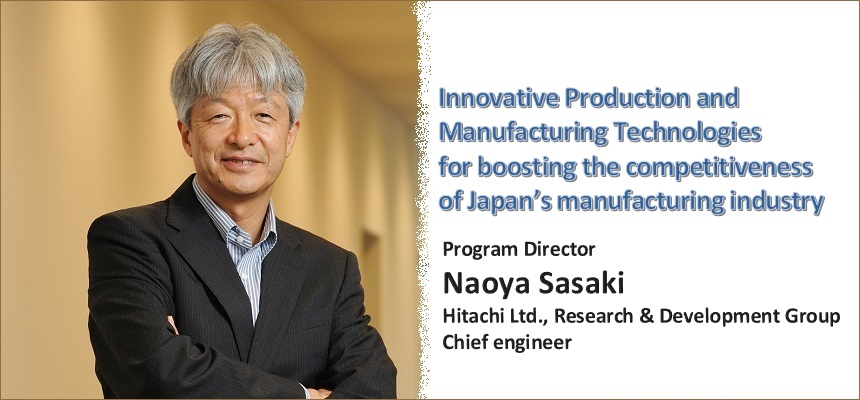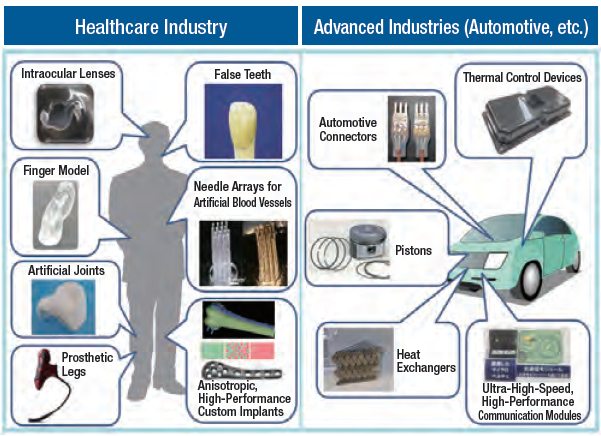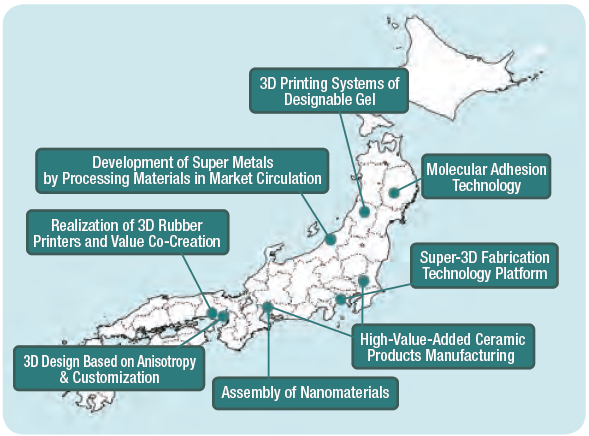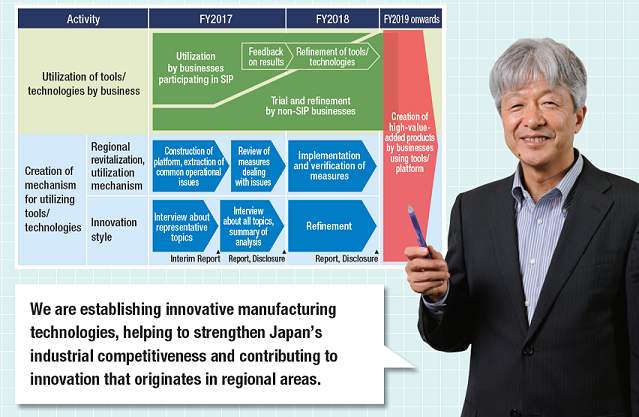Program Director Interview
Practical Application of Innovative Production and Manufacturing Technologies, Centered Around 3D Fabrication Using New Materials
The goal of this program is for manufacturing to achieve high added value, boosting the competitiveness of Japan’s manufacturing industry. During the program’s five years, we commenced activities aimed at the practical application of outcomes in some of our research topics, especially for production/manufacturing technologies. In conjunction with this, in order to realize innovative manufacturing across industry, academia and government, we have also advanced a concrete plan for a platform/system where developed tools and technologies can be used and we are promoting trials by external users.
Interview with Sasaki Program Director [Japanese] (Link to Youtube)
Responding to Diverse Manufacturing Needs
This program aims to stimulate manufacturing and create new markets supporting local economies, by linking business, universities and public institutions together. The program primarily promotes research that can be used by SMEs and microenterprises.
In terms of “innovative production and manufacturing technologies,” we are looking at innovative manufacturing technologies that take advantage of the specialized and unique technologies owned by participating businesses and universities. In particular, this program is focused on unconventional nonferrous materials and production technologies (ceramics, rubber, gel, super engineering plastics, etc.) in which Japan already has a competitive advantage. Here, researchers are developing materials that offer new value, and creating products with unprecedented complex shapes, functions and properties by means of various 3D fabrication technologies as well as molecular adhesion technologies which allow for different materials to be bonded together strongly.
As for “assisted design technologies utilizing optimization and simulation,” we are establishing technologies that take full advantage of innovative production and manufacturing technologies, on the basis of techniques for statistically evaluating diverse needs, topology optimization which allow structures and characteristics to be achieved that meet required specifications while also satisfying various constraints, and manufacturing process simulation technologies.
A number of technologies have already reached a level where they can be utilized by business, such as the 3D gel printer and the processing head used in laser coating described on the previous page. It is expected that other high-value-added products will be continue to be created using these technologies.
Initiatives for Practical Application in the Manufacturing Industry
Building on these outcomes, Program Director Naoya Sasaki comments, “Over the program's five years, by repeating a process of utilizing technologies in business, receiving feedback and further refining them, we will work to improve their degree of versatility and perfection so that industry can employ these technologies for high-value-added manufacturing.” To this end, topics for FY 2017 onwards have been carefully selected. In terms of innovative production and manufacturing technologies, the target areas linked to exit strategies have been specified as future growth industries, the healthcare industry offering new business opportunities, and the advanced automotive and aircraft industries. A particular focus has been placed on 3D fabrication technologies, centered around 3D printers as a technology creating new added value, and on manufacturing technologies that add high value to components and products, such as surface treatment and bonding. As for design, the focus has been placed on technologies utilizing optimization, which have liberated manufacturing from conventional constraints thanks to 3D printers, and on technologies which support process design corresponding to new manufacturing technologies.

Sasaki continues, “Japanese materials and components manufacturers possess highly specialized technologies, as well as high-quality, high-efficiency production/manufacturing techniques. However, more than a few specialize in custommanufacturing due to divisions of labor. To strengthen the competitiveness of Japan’s industries, it is important that regional SMEs and microenterprises be given advanced expertise from universities and public institutions, and that they establish new methods and techniques. To achieve this, an environment is necessary where they can experience and utilize newly developed tools and technologies. My hope is to provide for such a mechanism that can be maintained even after the end of SIP.”
As part of this program, there are plans to also build utilization hubs of tools and technologies. Several tools and technologies have already been set up at local public research organizations, and businesses have used them on a trial basis. This will lead to construction of a mechanism, taking into account any issues that arise here.

Building Greater Potential for Japanese Manufacturing
Going forward, in order to further deepen “innovative manufacturing,” we plan to strengthen research topics from the perspectives of practical application and regional revitalization.
SIP’s vision for the future is to form a platform/system for innovative manufacturing, based on innovative design and manufacturing technologies yielded through this program, and on a network of people across industry, academia and government. This will also contribute to the improvement of industrial productivity and the creation of new industries, which are two objectives of “Society 5.0” listed in the government’s 5th Science and Technology Basic Plan, and will help enhance our captivating manufacturing industry.
Future Plans
From FY 2017 onwards, we will focus on promoting initiatives aimed at the practical application of development outcomes. We will also work on building a platform/system designed for utilizing those outcomes, and we will provide an environment which facilitates regional SMEs and microenterprises in continuing to create high-value-added products even after the conclusion of SIP.

- Profile
- Naoya Sasaki
Dr. Naoya Sasaki joined Hitachi, Ltd. in 1982. He assumed the duties of corporate chief engineer in 2014. Throughout his career, Dr. Sasaki has been engaged in the development of mechatronic products and the development and spread of mechanical systems technologies and molecular simulation technologies. He holds a Ph.D. in engineering. Dr. Sasaki has been named a fellow of the Japan Society of Mechanical Engineering, and serves as Chairperson. He has also been named a fellow of the Japan Society for Computational Engineering and Science, and serves as an auditor. Dr. Sasaki is also a member of the Japanese Society of Tribologists.

